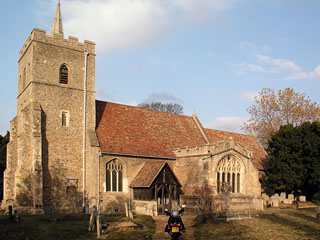All Saints is within a stone's throw of its larger cousin St Mary the Virgin at Great Shelford. The two villages have almost run together, but they are still separated by a little wood and the water-meadows of the Cam as it winds its way lazily north towards Grantchester. The church sits on the crossroads at the heart of the village.
From the outside, it looks generally undistinguished save for the vast south chapel cum transept, which has a huge and rather elegant Perpendicular window filling its southern wall. I hurried inside. I was nearly put off by the porch door, which was so stiff that I assumed it was locked. The inner door was open when I visited by myself, but locked when Mark and I returned to take photos - there is a keyholder listed, though.
The interior is entirely carpeted and has strange pine seating. I has the rather irreverent thought that it made the nave look like a lounge, but that's probably because I'm young and uncouth. It has no aisles, and there were some little rounded windows. The north door - now blocked - is also rounded, so I imagine that the main body of the the church was originally Norman. The north wall is populated by lots of memorial plaques.
 |
The floor level of the south aisle is much higher than the nave. This is entirely a Perpendicular affair; so big are the windows (now filled with clear glass) that it feels like it belongs more to the street outside than to the dark little Norman nave. The south window is every bit as grand as it looks from outside - it has five lights and particularly good tracery in the top. The chapel was built as a chantry for the local de Freville family, and apparently there are some brasses in the floor, though I didn't notice them. [Mark adds: I noticed them, they give a splendid example of the incremental changes in funerary fashion. The figures of Sir Robert and his wife are full frontal and severe, the joining of hands seeming (as was probably the case) more a statement of a property alliance than one of affection - how different with their son, Sir Thomas and his wife Margaret repeat the same gesture, but they are looking at one another and the effect is quite different.]
I was too surprised and excited by the splendid canopied niche in the south-east corner; it has a tiny vault over the niche itself, and the canopy turns into a free-standing spire with crockets and so on reaching almost up to the ceiling. The whole lot is supported by an angel underneath, and it contains a 15th century alabaster figure of a seated male saint. There was another niche on the other side of the altar at one point, but it was so badly smashed that only a bit of the supporting angel remains. I doubt, therefore, that the statuette is originally from here - but it fits in very well. There's a companion piece - the upper part of a female figure - on the other stump.
The chancel is rather spoiled by the ugly little organ sitting against the south wall. The north wall, though, is very interesting. it contains two very broad low arches. The westernmost one is the less elaborate of the two, the only decoration being a little three-leaf carving at the point. Beneath it, an ancient little door presumably leads to the vestry. The eastern arch is much more elaborately ornamented, with little buttresses and finials. In the recess beneath it lies an oak effigy of Sir John de Freville, who died in 1308. He has a little moustache and a surprised expression. Above him on the back wall is an inscription in Lombardic characters - translated it reads "Here lies Sir John de Freville lord of this village / You who pass of your charity pray for his soul".
All Saints seems to be open most of the time.
There are keyholders listed if you find it closed.
